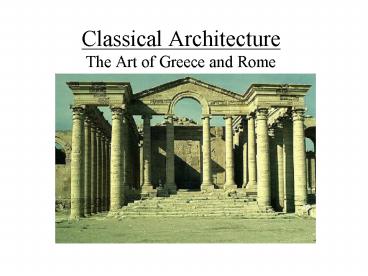Classical Architecture The Art of Greece and Rome - PowerPoint PPT Presentation
1 / 13
Title:
Classical Architecture The Art of Greece and Rome
Description:
They are known for for their incredibly realistic sculptures. ... formed Greece squabbled and remained separate as small city-states Greeks were amazing artists ... – PowerPoint PPT presentation
Number of Views:3031
Avg rating:5.0/5.0
Title: Classical Architecture The Art of Greece and Rome
1
Classical ArchitectureThe Art of Greece and Rome
2
Greece
- Around 1500 B.C., different groups settled in the
Aegean Sea - Greece never became a nation because the tribes
that formed Greece squabbled and remained
separate as small city-states - Greeks were amazing artists though. They valued
grace, harmony and precision. They are known for
for their incredibly realistic sculptures.
3
The Parthenon
- The Greeks were also incredible architects.
- The Parthenon, which we saw during the Olympics,
is thought to be the most perfect building ever
created.
4
Classical ArchitectureClassicism - The
architectural style that has shaped Western
architecture ever since ancient Greece.
Characterized by architectural elements such as
columns and orders.
These are the basic parts of a Greek or Roman
building Cornice Pediment Frieze Columns
FAÇADE The front view of a building
5
The Column
- The design at the top of a column is called the
capital - Capital design has helped art historians and
scholars figure out when Greek and Roman
buildings were built. - There are three main orders or capital styles
- Doric, Ionic Corinthian
6
Roman Architecture
- Because the Greek city-states were unable to band
together, they were helpless to outside attacks. - In 197 B.C., Greece fell to the Romans
The Pantheon
Triumphal Arch
7
Roman Architecture
- The Romans were very practical people and were
more interested in law, government and
engineering than art. - They were clever architects and city planners and
we still benefit from their contributions.
- Concrete The Romans figured out how to make
concrete which is a mixture of sand, minerals and
small pebbles.
8
The Round Arch
- The Romans invented the round arch
- A curved arrangement of stones over an open
space. This opened up many new building
possibilities. - Concrete enabled the Romans to build grand
structures with arches and rotundas.
What kind of architectural form is this?
9
- Architectural Vocabulary
- Arch - A curved structure used as a support over
an open space - Capital - The decoration at the top of a column
- Column - A slender, upright structure, usually
supporting member a part of a building. - Cornice A decorative architectural projection
or edge - Corinthian column - In classical architecture,
the last capital order designed after the
Egyptian columns and inspired by palm trees. - Frieze - A band with designs or carvings along a
wall or above doorways and windows. - Pediment - A low triangular gable above a
cornice, topped by raking cornices and
ornamented.. Used over doors, windows or porches.
- Portico - A large porch usually with a pediment
roof supported by classical columns or pillars - Classicism - The architectural style that has
shaped Western architecture ever since ancient
Greece. Characterized by architectural elements
such as columns and orders. It is a language that
has continually reinvented itself.
10
Examples of Major Roman Architectural Structures
- The Triumphal Arch
11
The Aqueduct
- A network of channels used to carry water
distances, to cities
12
The Temple
- Greek temples were used to house their gods.
Roman temples, like the Pantheon, were built by
people for prayer.
13
The Amphitheater
- A circular structure characterized by rising
tiers of stone seats contained within an arched
stone outer wall that was used by Romans for
circus performances and gladiatorial contest.































